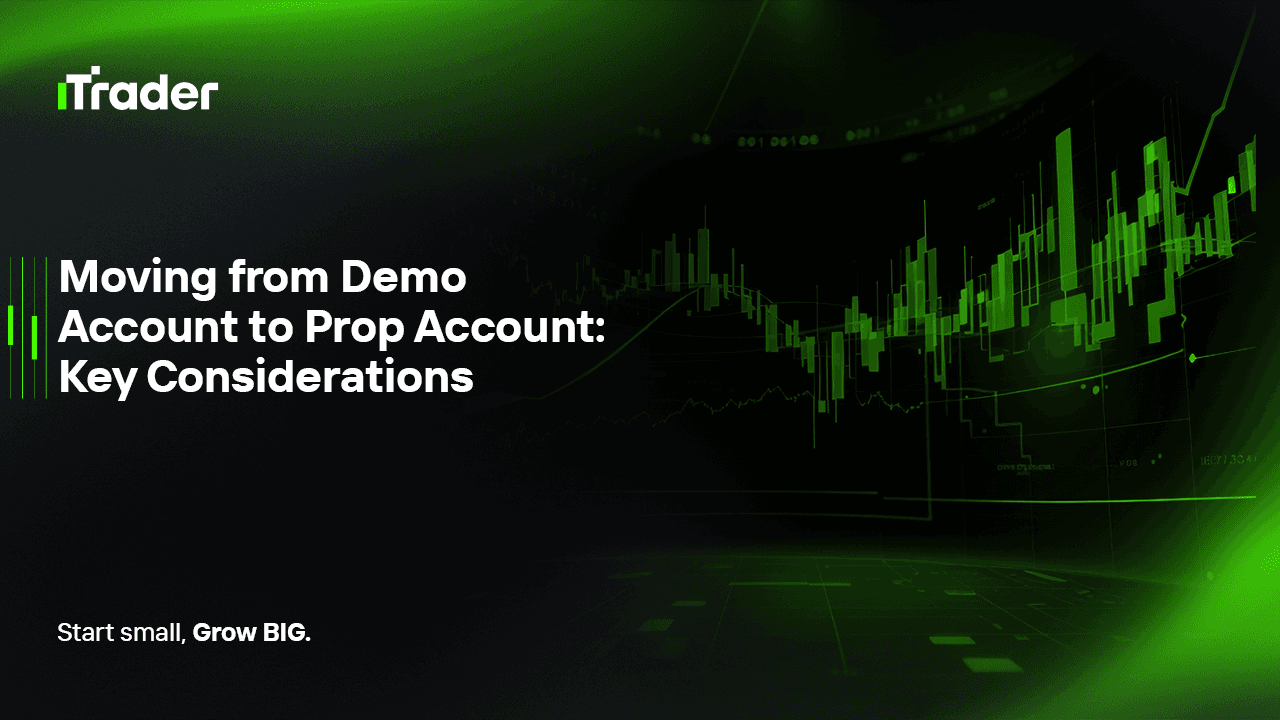2025-09-16
For most aspiring forex traders, the journey begins on a demo account. It’s a safe environment where mistakes cost nothing, strategies can be tested freely, and confidence can be built without the pressure of real money. But at some point, every trader faces the big leap — moving from demo to a prop account, where real capital is on the line and strict rules apply.

This transition isn’t just about proving your technical skills. Prop firms evaluate traders on much deeper levels: risk management, discipline, psychological resilience, and consistency. Passing this phase means showing that you can handle not only the charts but also the emotions, rules, and capital entrusted to you.
In this blog, we’ll break down what you should pay close attention to when making this critical shift, and how to prepare for success in a prop firm environment.
On the surface, demo and prop accounts look similar — you open trades, watch price movements, and manage positions. But the dynamics are very different:
Understanding these differences upfront is essential because many traders stumble not due to lack of skill but due to underestimating the psychological and structural changes.
A demo account is not just for testing whether a strategy “works.” It’s where you build the habits that will carry you through prop challenges. Before attempting a prop account, ensure you’ve:
Think of demo as your rehearsal stage. You don’t pass to the main show (prop account) until you can consistently perform on this smaller stage.
The biggest hurdle in moving from demo to prop is not technical but psychological. When money is real (even if it’s the firm’s), your brain reacts differently:
To manage this shift, you must prepare mentally as much as you prepare technically.
Prop firms don’t care if you make 20% profit in a week. They care if you can protect capital while generating returns. That’s why risk management takes center stage:
In fact, most prop firms would rather see a trader earn 5% with tight drawdowns than 15% with reckless exposure.
The goal in a prop challenge is not to prove you’re a genius trader — it’s to demonstrate you’re a reliable, consistent risk manager. Here’s how to approach it:
Remember: Prop firms are evaluating how you’d handle their money long-term, not just whether you can hit a short-term profit goal.
Moving from demo to prop should not be impulsive. A structured transition plan increases your odds of success:
This staged approach prevents emotional burnout and builds confidence step by step.
Many traders fail prop challenges not because they lack skill, but because they repeat avoidable mistakes:
Awareness of these pitfalls can help you sidestep them.
The demo account is your training ground. The prop account is your audition. Passing it successfully is not the end goal — it’s the beginning of your professional career.
Think of it as stages:
Each stage builds on the previous one. Skipping steps or rushing leads to failure, while gradual mastery leads to long-term success.
Transitioning from demo to prop is one of the most challenging and important steps in a trader’s journey. The skills that served you well on demo — strategy testing, execution practice, risk calculation — now must be reinforced with discipline, emotional control, and strict adherence to rules.
To succeed, remember:
If you respect the process, master your emotions, and trade with consistency, you’ll not only pass prop challenges but also position yourself as a trader capable of long-term growth and professional success.
© 2025 iTrader Global Limited | 公司注册号 15962
iTrader Global Limited 位于科摩罗联盟安儒昂自治岛穆察姆杜 Hamchako,并受科摩罗证券委员会(Securities Commission of the Comoros)许可及监管。我们的牌照号为 L15962/ITGL。
iTrader Global Limited 以“iTrader”作为交易名称,获授权从事外汇交易业务。公司的标志、商标及网站均为 iTrader Global Limited 的专属财产。
风险提示: 差价合约(CFD)交易因杠杆作用存在高风险,可能导致资金快速亏损,并非适合所有投资者。
交易资金、差价合约及其他高杠杆产品需要具备专业知识。
研究显示,84.01% 使用杠杆的交易者会遭受亏损。请务必充分了解相关风险,并确认在交易前已做好承担资金损失的准备。
iTrader 特此声明,不会对任何个人或法人在杠杆交易中产生的风险、亏损或其他损失承担全部责任。
本网站提供的新闻及信息仅用于教育目的。用户应独立且审慎地作出金融决策。
限制条款: iTrader 不会向法律、法规或政策禁止此类活动的国家或地区居民提供本网站或相关服务。若您居住在限制使用本网站或服务的司法管辖区,您有责任确保遵守当地法律。iTrader 不保证其网站内容在所有司法管辖区均适用或合法。
iTrader Global Limited 不向以下国家/地区的公民提供服务,包括但不限于:美国、巴西、加拿大、以色列及伊朗。